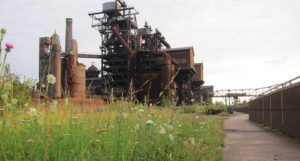Just 30 tree species dominate world’s most diverse savanna

The study draws on data from over 200 one-hectare field plots. Photo: Professor Ted Feldpausch
Scientists have found that a mere 30 species of trees in the Cerrado – the world’s largest and most floristically diverse savanna – account for nearly half of all its trees.
This phenomenon of “hyperdominance” by a few species has significant implications for understanding and conserving this important ecosystem.
The study, by scientists from Brazil, UK, and the Netherlands and published in Communications Biology (Nature Portfolio), draws on data from over 200 one-hectare field plots combined with satellite imagery and spatial modelling.
Thirty species – less than 2% – of the Cerrado’s 1,605 tree species were found to account for almost half of all trees, and among this distinct group of hyperdominant trees, one species, Qualea parviflora, made up one in every 14 trees.
“We were surprised by this level of hyperdominance in such a diverse ecosystem,” said lead author Dr. Facundo Alvarez, from the State University of Mato Grosso (UNEMAT).
“This pattern is similar to what’s been observed in the Amazon rainforest, although the Cerrado is a savanna. Our research also determined that the Cerrado has lost an estimated 24 billion trees since 1985 – a staggering figure equivalent to three times the Earth’s current human population. Understanding the dominance of these few species is essential in light of such losses.”
Spanning 2 million km2 – an area the size of England, France, Germany, Italy and Spain combined – the Cerrado is the largest savanna in the world and the most floristically tree diverse, as well being a gateway to the Amazonia and playing a vital role in supplying clean water and sequestering carbon.
This hyperdominance of a few species, now found in both Amazonian forests and the Cerrado, highlights the risks both biomes face for species loss due to fragmentation, deforestation and land-use change.
“When so many ecosystem processes are concentrated in 30 or so individual species it means that if you disrupt this system, for example through climate change, then depending on how those species respond to that disruption there’s a risk of losing the species that are key to maintaining core functionality of the savanna as a savanna,” said co-author Professor Ted Feldpausch from the University of Exeter.
As only 30 species dominate the Cerrado, its stability and functioning are very narrowly based. But Professor Feldpausch explains that focusing on these species could help researchers understand how this vast ecosystem functions.
“It could help us make predictions about how the system as a whole is going to function – and potentially how it will respond to disruptions, whether from changing fire regimes or a changing climate,” he said.
Lead co-author Professor Beatriz Marimon, from the University of Mato Grosso State (UNEMAT), added: “It’s going to help us with conservation, knowing where we find higher and lower diversity; it’s going to help with management – so knowing, for example, whether these are species are more or less adaptive to fire; and if we’re trying to restore areas, understanding these few species is going to help with that too.”
The critically endangered Cerrado biome plays a crucial role as the gateway to the Amazonia and other biomes but is just 8% protected and more than half deforested.
To date, it has acted as a barrier, helping to separate the Amazonia from the densely populated and urbanized southeastern region of Brazil.
The Cerrado plays a crucial role in supplying water to major cities, regulating climate, and acting as a natural barrier between the Amazon and Brazil’s heavily populated southeast. “Yet global environmental policies continue to overlook the Cerrado,” said co-author Professor Ben Hur Marimon Junior from UNEMAT. “Its protection must become an international priority — not a burden carried solely by local communities.”
The researchers warned that up to 800 tree species may remain undetected and face extinction in a few decades due to deforestation.
The research was conducted by a team of 35 scientists from Brazil, the UK, and the Netherlands, with support from the Brazilian Federal Agency for Support and Evaluation of Graduate Education (CAPES) and the UK’s Natural Environment Research Council (NERC).



